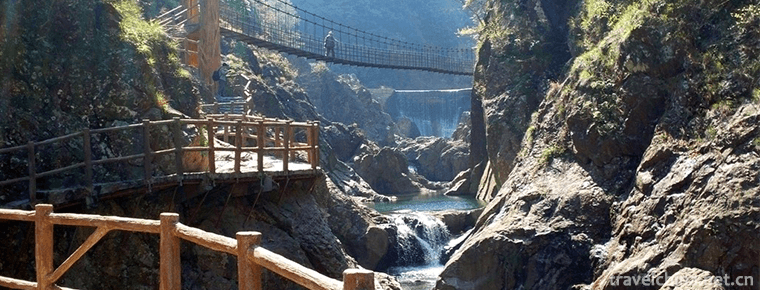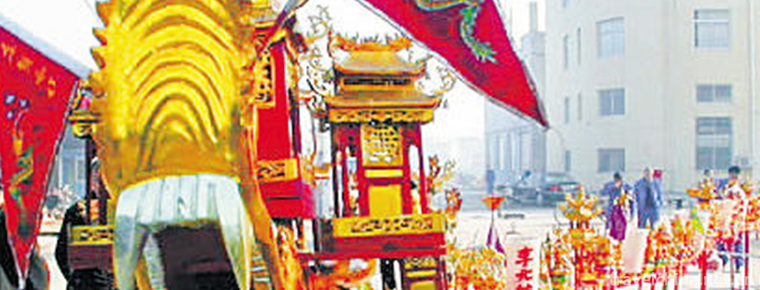2019-01-04

- By ChinaWiki.net
- Chinese Edition
- 2020-10-16
Fobao ancient town
Fubao ancient town is an ancient town with a long history in Hejiang County, Sichuan Province, 42 km away from Hejiang County, Sichuan Province. It is a historical town, a famous cultural town, a tourism town, and an important business town in the junction of Sichuan, Guizhou and Chongqing. It was built in the late yuan and early Ming Dynasty, more than 600 years ago, it is named Fobao, and it is the gateway of national Fobao forest park.
Introduction to the ancient town
The ancient town was built at the end of the Yuan Dynasty and the beginning of the Ming Dynasty. By the end of the Ming Dynasty and the beginning of the Qing Dynasty, it has become a political, economic and cultural exchange center of the dacaohe River Basin. Huilong street in Fubao ancient town is the best preserved ancient street in the town. Along the Huilong bridge, on both sides of the street paved with big bluestones, there are one house by one house, forming Jiulong lane, Liujia lane, Baoqing lane, chaishi lane and Jishi lane. The street, 450 meters long and 1.5-8.0 meters wide, was the most bustling and prosperous area at that time, which was covered by ancient buildings such as Huilong bridge, three palaces and eight temples, and Xizi Pavilion. Most of the existing ancient buildings were restored during the period from Qianlong to Guangxu of the Qing Dynasty. There are 25 representative buildings such as "three palaces and eight temples". Fubao ancient town is surrounded by mountains and rivers, with three streams and five bridges. The smooth and narrow ancient streets and alleys, like the ethereal tunnel of time and space, lie across the bright moon hill and the White River. They are circuitous, crisscross and ups and downs, which make people think about it for thousands of years, and sprout a deep-rooted love. The ancient dwellings, which are shaped according to the situation, are full of the magnificence of the mountain villa and the beauty of the watery land. They are like a magnificent folk painting scroll, which makes people travel in all directions and return to the simple reverie. Diao Liang Huadong, witness the eventful years; cornice warping angle, bathing in the vicissitudes of the wind and rain. The unique style of the beautiful landscape blending with the landscape in the old town of Buddha demonstrates the highest realm of harmony between man and nature. Profound historical and cultural details and rich and colorful folk customs are of valuable architectural aesthetic value and rare tourism appreciation value. They are praised by Chinese and foreign experts as "China's fine building in Mountain Architecture", "solidified space Symphony" and "the most beautiful ancient town in Sichuan".
Ancient town scenic spots
Huilong ancient street in Fobao ancient town (Sichuan dialect drama - shooting point of fool commander): including Huilong street, main street, bazaar and other ancient buildings, complete scenic spots are reserved. Huilong bridge in Fobao ancient town was built in the 20th year of Daoguang, with a total length of 25 meters, a bridge deck width of 4 meters and an arch height of 6 meters. A dragon is engraved in the center of the bridge. The bridge is hung with a sword, and it crosses the White River (Huilong River). The bridge street is paved with large bluestones. The balustrade is carved into a Xieshan roof style. It is the only stone arch bridge in the DACAO river of Fubao at that time.
Fubao ancient town has three palaces and eight temples, namely Qingyuan palace, Wanshou Palace, Tianhou palace, Wuzu temple, Tudi temple, Zhangye temple, Yuwang temple, Huo temple, dengpeng, Wangye temple and Guanyin temple. Their layout is reasonable, and the pattern is basically in good condition. Most of them have theatres, chamber buildings, patios, plank walls, frames, falcons, carved beams and painted buildings. Except for Wangye temple, dengpeng temple and Guanyin temple, the rest of the temples account for 2 / 5 of Huilong street.
Xizi Pavilion in Fobao ancient town is located under a rhubarb horned tree. Although it is not grand and spectacular, it also shows its simplicity in the shade. The Xizi pavilion was built in the 55th year of Qianlong reign. It has six floors and eight squares. It imitates the eight trigrams and is 8 meters high. Each floor is engraved with deep relief patterns. It is different from each other. It is the place where the "Tianhou Palace" burns money into paper, so it is also called "Ziku", commonly known as "Huaqian stove".
Other relevant
The old town of Fobao has a variety of buildings, and rows of wooden buildings with hanging feet are arranged at random and fluctuate with the mountains. The street is seven or eight meters wide and only about one and a half meters narrow. All of them are paved with bluestone slabs. The stone steps rise and fall, winding to the front. From time to time, we can see people holding umbrellas up and down the stone stairs, showing a poetic picture of a small town in the rain.
Due to its remote location, Fobao ancient town is a little lonely, but the overall preservation is relatively good, and the style is still the same. The most fascinating thing is that such a large ancient town looks so simple and quiet, without any noisy atmosphere. In the small town, no matter who you step into, which door, you can visit at will. Simple mountain people will also be easy to cooperate with photography, happy to meet the distant visitors' desire to seek novelty and explore.
Fobao ancient town has a long history of culture, and there are many kinds of folk arts, such as performing lantern opera, singing folk songs, playing with guns, playing lanterns and lion dance. In particular, the unique performance of Fubao suona gongs and drums has been praised as "a rare treasure of folk culture and art" by the famous aesthetician Wang Chaowen. As early as the end of Qing Dynasty, Fobao flavor snacks have been famous in southern Sichuan and Northern Guizhou. There are traditional crisp cakes, dried tofu, fried Ciba, and bamboo series "panda banquet" mainly composed of green food such as bamboo shoot tip, Magnolia, bamboo shoot, Dictyophora, etc. in addition, the flavor of lychee, forest game and plum wine will make visitors from afar enjoy themselves.
Ask a Question
Your email address will not be published.



0 Questions